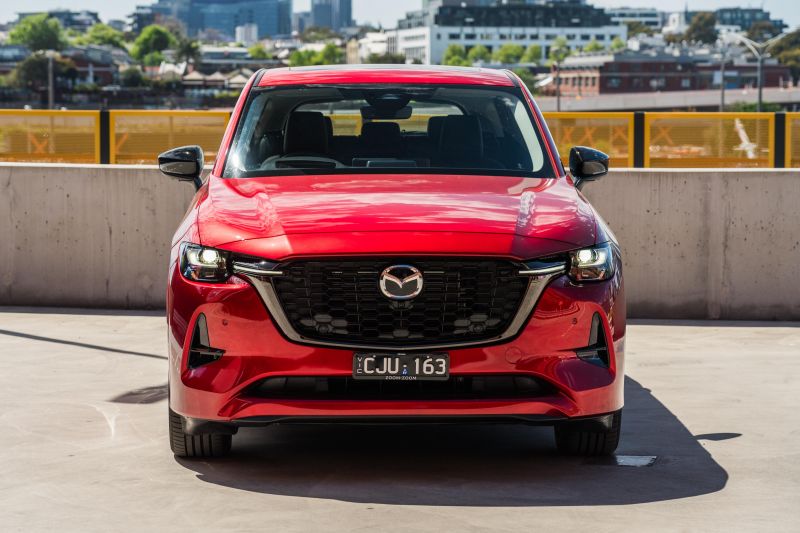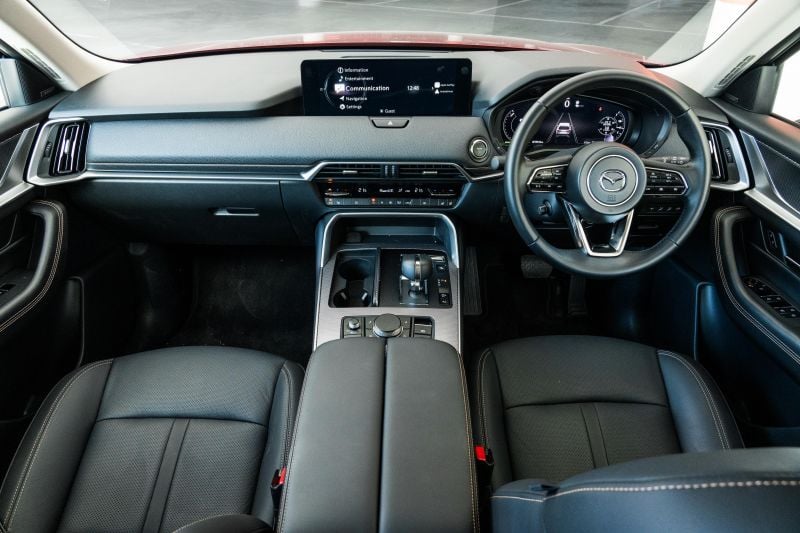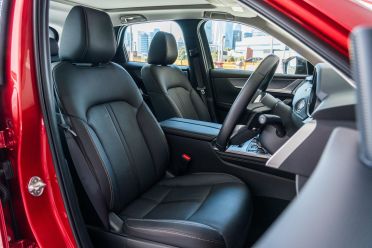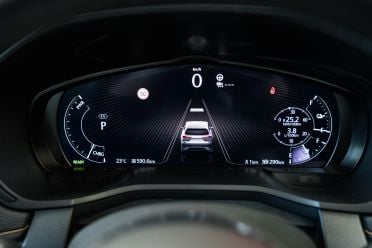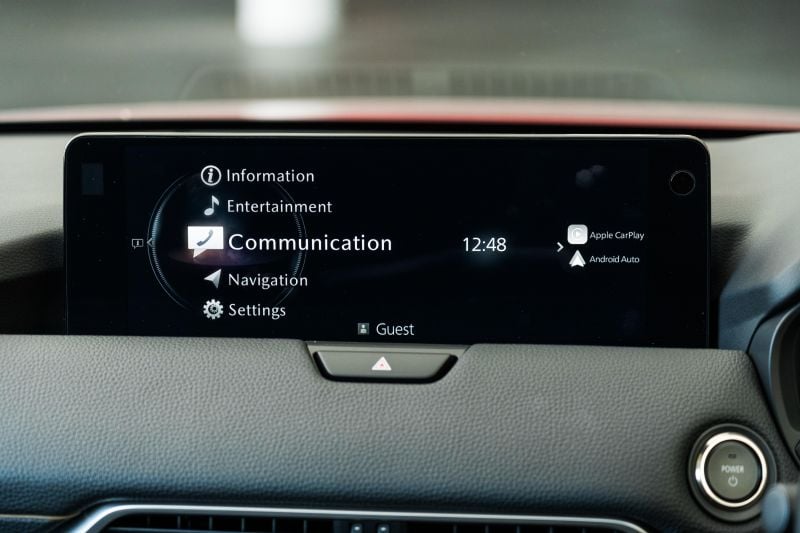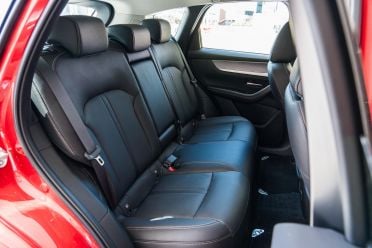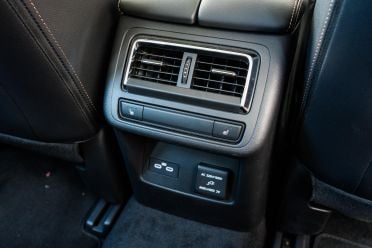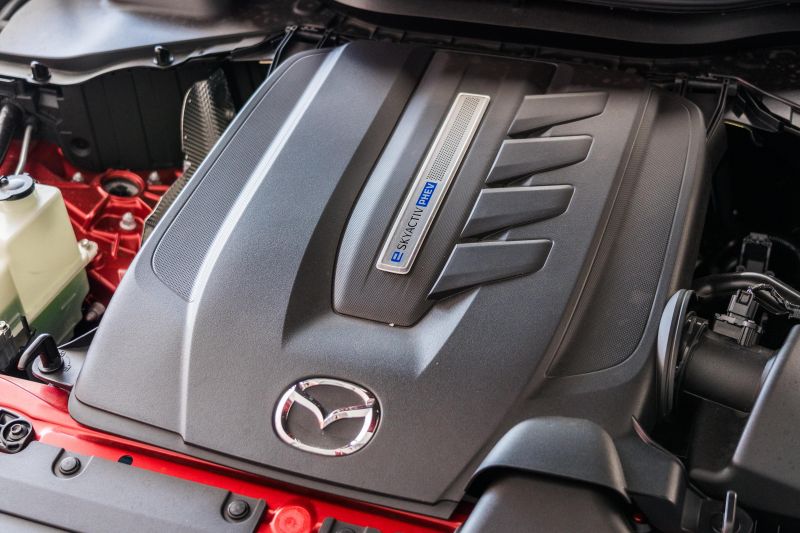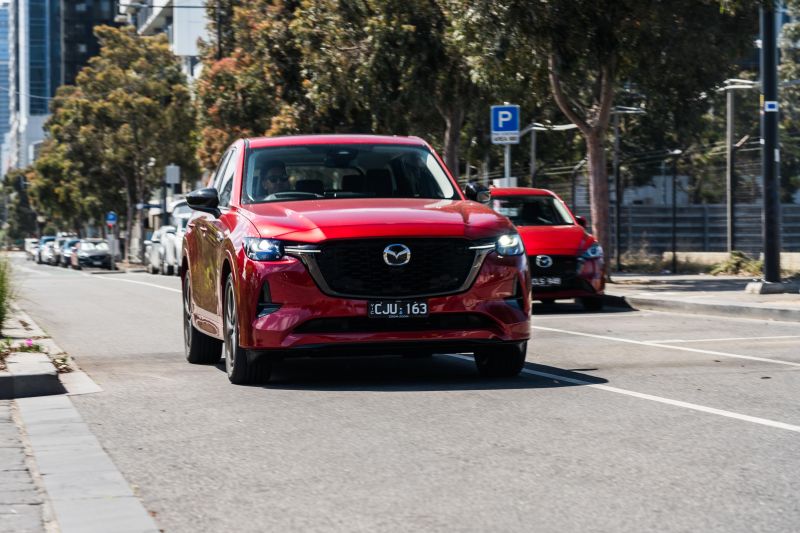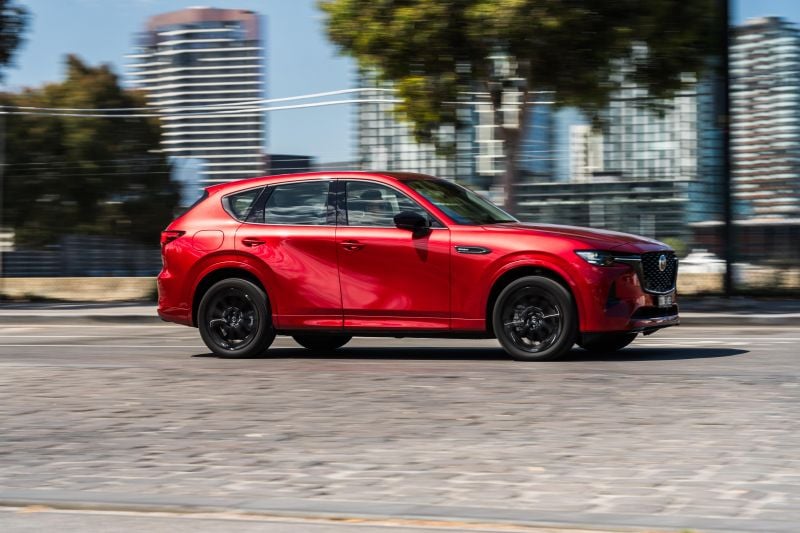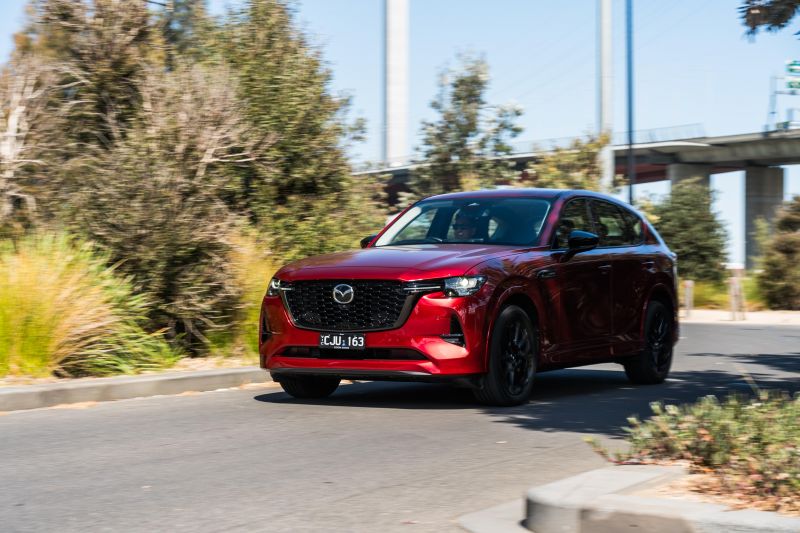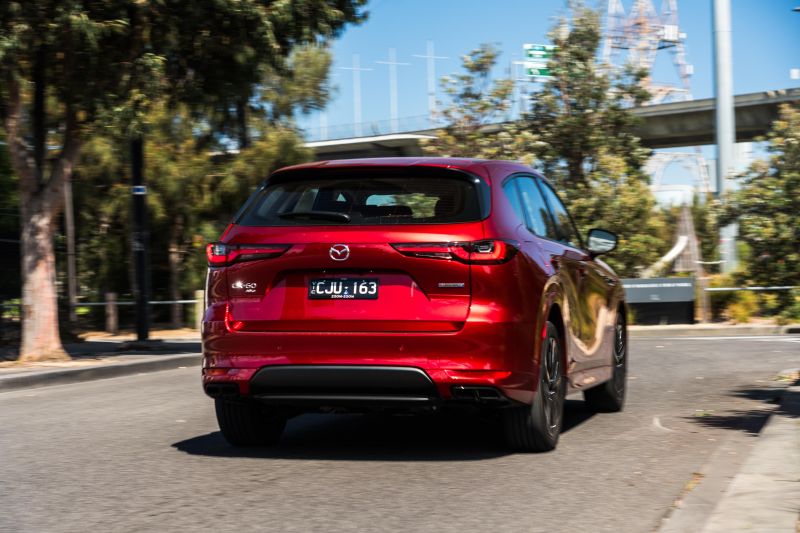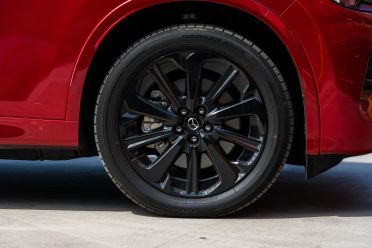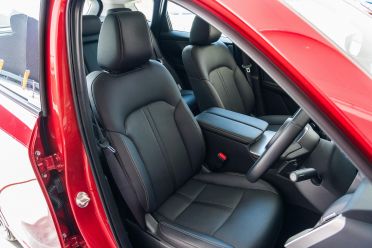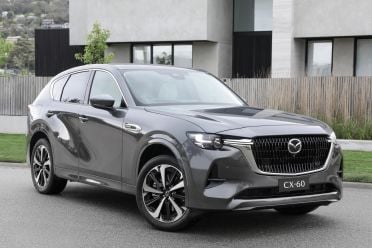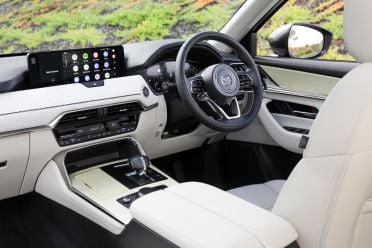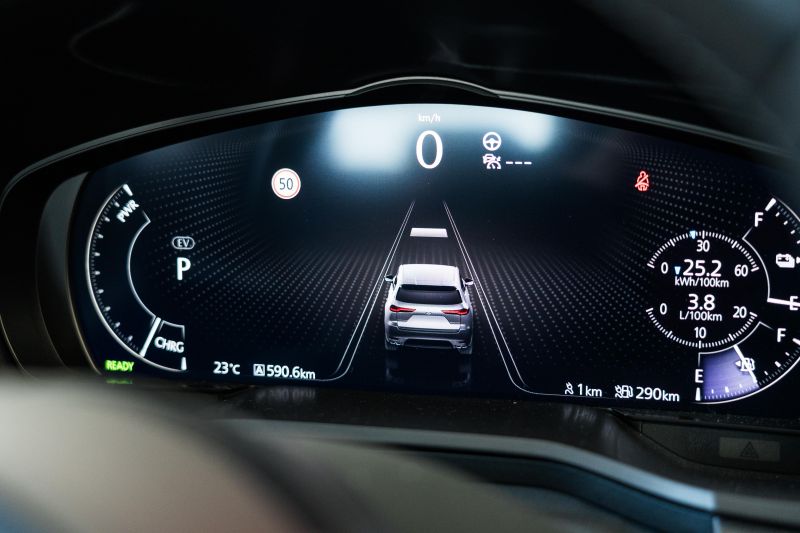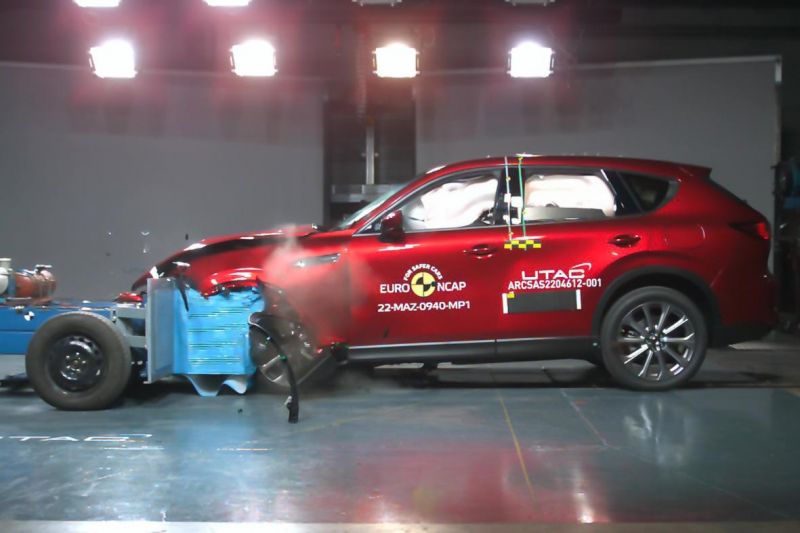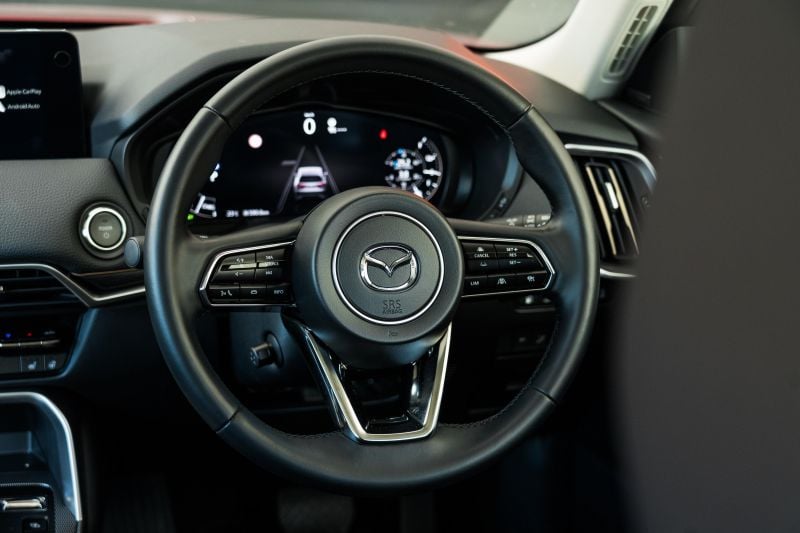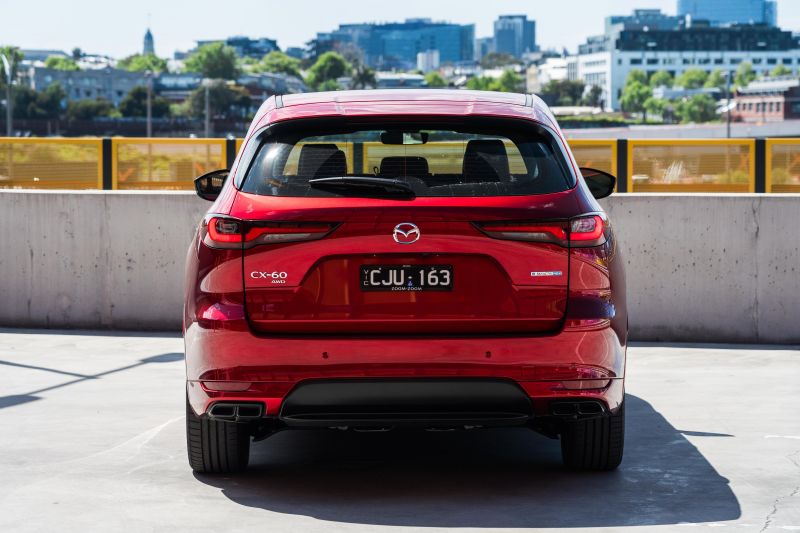You’re looking at Mazda’s first plug-in hybrid.
The 2024 Mazda CX-60 P50e is the first time the brand has offered PHEV tech, and for a brief period it was also the most powerful series production vehicle the company had ever produced.
Plug-in hybrids are still a niche in Australia compared to conventional hybrids like the Toyota RAV4 Hybrid as well as electric vehicles like the Tesla Model Y – these two are actually Australia’s favourite SUVs right now.
While the CX-60 was always meant to be Mazda’s push towards competing against premium players, the fact its new rear-biased mid-size SUV offers such new powertrain tech makes it more important than sales figures might suggest.
For many loyal Mazda customers, this is the first taste of proper electrification. While the company has offered 24V mild-hybrids in the past, they weren’t particularly competitive with proper hybrids. The all-electric Mazda MX-30 was a compliance car and wasn’t a particularly notable effort, either.
We’re still waiting for Mazda to come out with a proper Tesla rival, but the CX-60 is its first go at competing with established players in the PHEV space. Rivals include everything from the Mitsubishi Outlander Plug-in Hybrid EV, to the Audi Q5 TFSI e, Lexus NX 450h+ and Volvo XC60 Recharge.
On test we have the mid-spec GT which is a smidgen under $81,000 before on-road costs. On paper, it should be something of a Goldilocks variant in terms of balancing value with standard inclusions. With its standard black pack and optional Soul Red Crystal paint seen here, it looks pretty schmick.
Should you buy one if you’re in the market for a new PHEV? Let’s find out.
How much does the Mazda CX-60 P50e GT cost?
2024 Mazda CX-60 pricing:
- Mazda CX-60 Evolve
- G40e M Hybrid: $60,400 (+$600)
- D50e M Hybrid: $62,400 (+$600)
- P50e PHEV: $72,900 (+$600)
- Mazda CX-60 GT
- G40e M Hybrid: $68,400 (+$600)
- D50e M Hybrid: $70,400 (+$600)
- P50e PHEV: $80,900 (+$600)
- Mazda CX-60 Azami
- G40e M Hybrid: $73,600 (+$600)
- D50e M Hybrid: $75,600 (+$600)
- P50e PHEV: $86,100 (+$600)
Prices exclude on-road costs
What is the Mazda CX-60 P50e GT like on the inside?
I’ve spent plenty of time in the Azami variants and their various option packages, which are quite posh, and while the GT is a little more plain it’s still premium-leaning.
The vehicle on test featured a standard black leather interior; though, there’s an optional Revera Stone upholstery on GT models which brings a wood-look trim insert instead of the patterned plastic designed to look like aluminium.
Other than the finishes, the rest of the cabin is much like other CX-60 versions we’ve driven. There’s lots of straight lines and chunky consoles, plenty of padded surfaces and a general feeling of quality to the fit and finish.
Yes, in this spec it does feel more like a dressed-up Mazda than a proper premium competitor like the Azami, but it’s not really that far off the ambience of a lower-grade Audi Q5 or Lexus NX in most ways. It’s actually bigger than both those cars too if you count space as a measure of luxury.
I’m not a fan of the heavily grained dashboard insert and the lack of a stitched leather-like finish for the door tops, like you have in top-spec CX-5 and CX-8 models. It all looks a bit like toad skin, and while nice to the touch doesn’t look high end compared to some of the finishes you’ll find in premium alternatives.
Comfort and practicality up front is good as we’ve found in other variants. There’s a decent range of storage options, there’s good range of adjustment in the electric front seats, and it’s pretty ergonomically sound as you’d expect from Mazda.
The GT also scores two-position memory for the driver’s seat and electric steering column adjustment, which is a very Lexus-like touch, meaning you don’t have to shell out for the Azami for all the luxuries. For reference, the driver gets 10-way electric adjustment and the passenger gets eight ways, while the front pews are heated (but not ventilated like the Azami).
A pair of 12.3-inch displays sit ahead of the driver, one for the digital instrument cluster and then the other for the central infotainment system. Like we’ve mentioned in previous reviews of the CX-60, the Mazda Connect infotainment system is pretty much a blown-up version of the interface we’ve seen on other Mazda models.
It’s well-featured in offering wireless Apple CarPlay and Android Auto, native satellite navigation as well as DAB radio. There are no connected services yet; however, Mazda Australia will commence the rollout of net-based functions in 2024 starting with the updated MX-5 sports car.
Otherwise it all works pretty well with good response and fluid animations, and being a PHEV there’s some extra menus and content if you go diving through the ‘Information’ section.
Mazda only offers touch functionality when the Mazda Connect system is using smartphone mirroring and the vehicle is stopped, otherwise you’re limited to the BMW iDrive-style rotary controller on the centre tunnel which you can get used to but it gets quite fiddly when using Apple CarPlay, for example.
Numerous colleagues have complained about the usability. I guess it’s worth having a try for yourself and seeing if it grates on you as much. For me, I got over it fairly quickly or just used Siri voice commands.
The system was also very good at maintaining its connection with my phone, not dropping around known interference points in Melbourne. Further, the 12-speaker Bose premium audio system offers pretty clear sound with decent bass.
Mazda has stuck to physical switchgear for the climate controls, which is great. There’s a nice solid feel and action to them, helping to uphold that perception of quality.
There’s a pair of cupholders alongside the shift-by-wire selector first seen in the MX-30, and ahead of that are the wireless phone charger and USB-C inputs.
Storage elsewhere up front includes decent door bins and a deep cubby underneath the dual-lid centre armrest – so you can open half of it without disturbing your passenger.
Given how big and chunky various parts of the cabin area are; however, I would have liked to see better optimisation of the various nooks and crannies available to better fit your odds and ends.
That theme somewhat carries through to the rear, with the CX-60’s large-for-the-segment external dimensions not translating to segment-busting second-row accommodation – it’s more Audi Q5 or Lexus NX than BMW X3.
Behind my driving position (I’m 6’1) I had enough head, knee and toe-room to get comfortable, with a good view out the rear windows. I’d wager two adults will be fine, three would be a pinch. The minimal centre tunnel at least means a centre passenger isn’t too impeded in terms of foot space.
Amenities include rear air vents – though no separate climate controls – as well as USB-C and 150W AC outlets to keep devices charged. The GT and Azami also score heated outboard seats. There is no extra zone of climate, though.
There’s a fold-down centre armrest with cupholders, map pockets behind the front seats, as well as ISOFIX anchors on the outer positions and top-tethers across all three rear seats. Bottle holders in the doors round out the notable practicality features.
Cargo volume is quoted at 477 litres “to rear package tray” with all seats up, expanding to 1726 litres “to ceiling with underfloor storage space” with the rear seats folded. That’s just under 40 litres better than the CX-5 with five seats in use, and nearly 400 litres better with the rear seats folded.
Not bad, but somewhat off the pace of premium rivals like the Audi Q5 (520L-1520L), BMW X3 (550L-1600L) and Mercedes-Benz GLC (620L) with all seats in use.
Remote levers to drop the rear seats feature in the cargo area, and PHEV models have a 1500W AC outlet there too. Mild-hybrid versions get a space-saver spare wheel but PHEVs just get a tyre repair kit.
What’s under the bonnet?
| Model | Mazda CX-60 P50e PHEV |
|---|---|
| Engine | 2.5L 4cyl petrol + electric motor |
| Power | 241kW |
| Torque | 500Nm |
| Transmission | 8-speed automatic |
| Driven wheels | All-wheel drive |
| Weight | 2111-2139kg (kerb) |
| 0-100km/h | 5.9 seconds |
| Fuel economy (claim) | 2.1L/100km |
| Fuel economy (as tested) | 3.8L/100km |
| EV battery | 17.8kWh li-ion |
| EV driving range | Up to 76km |
| Fuel tank size | 50L |
| Fuel requirement | 91 RON |
How does the Mazda CX-60 P50e GT drive?
The CX-60 PHEV has a distinct personality from its petrol and diesel siblings, which makes it quite interesting.
As is the case with plug-in hybrids, you meant to use the CX-60 as an electric vehicle for daily commuting duties, with the petrol engine available as back up once you deplete the li-ion battery pack.
During my week with the CX-60 the petrol engine only ever came on if I went driving beyond my usual journeys to and from work in a single day, or if I demanded the full 241kW and 500Nm with a heavy right foot – it hustles when you do.
Like we’ve experienced with other CX-60 models, there are elements to the drive experience that are rough around the edges. The various creaks and moans of the drivetrain are a little unrefined, but on the flip side can make the vehicle seem a little more alive and even endearing depending on how you look at it.
On its own the electric motor makes 100kW/250Nm, and it’s mounted between the eight-speed auto and combustion engine. Together with a multi-plate clutch system, the e-motor also substitutes a conventional torque converter.
What that means in theory is the Mazda CX-60 PHEV should be more responsive to throttle inputs as the engine and e-motor’s torque is channelled directly to the gearbox with snappier shifting.
However, it isn’t perfect. Response off the line is good thanks to the immediacy of the electric motor’s torque, but the transmission can feel elastic through the first couple of ratios and the mechanical sounds coming through the driveline aren’t confidence inspiring, especially if it’s one of the first times you’re driving the car.
Should the petrol engine fire when you ask more of the drivetrain, its coarse note is unrefined and a little disconcerting. At least vibrations felt through the driver controls are pretty well subdued.
Performance in normal driving is fine. The e-motor’s outputs are enough to get the 2139kg CX-60 P50e GT moving with decent pace, though having the same outputs as a small petrol or diesel engine means it’s not exactly brisk. Best to drive this thing with restraint when cruising around in electric mode.
We’ve previously criticised the CX-60’s ride in other trims; it’s seemingly better in town than on the open road, particularly patchy country highways. It’s a similar story here; though, the PHEV is slightly softer across the board.
Mazda told us at the launch of its new crossover the different engine variants all had slightly different chassis tunes, and it seems the added weight of the PHEV components have led to a softer setup, mostly for good.
The CX-60 P50e is a little softer over the hits you’ll encounter in urban driving, be it speed humps, tram tracks, drain covers and road joins. It has a bit of extra bounce to the tuning which makes it feel a touch more compliant in daily scenarios; though, successive high-frequency hits can unsettle the ride.
However, it also means the PHEV feels the least sharp of the CX-60 range to drive when you find yourself threading through corners. There’s a touch of extra lean and heft, meaning while it’s the quickest version in a straight line, it’s not really the keen driver’s pick.
The heavy steering makes the car feel substantial but can also make parking more arduous, and lower-speed handling requires a bit more muscle.
Visibility is generally pretty good despite the long bonnet and high shoulder line, and the big mirrors and available surround-view cameras will help to ensure you don’t scrape the those pretty black alloys.
Being a PHEV there’s also a suite of drive modes to tailor the drivetrain to the conditions or your personal tastes. EV mode is the default when you start the car up with charge in the battery, and the car generally stays there unless you break the electric mode speed cap of around 100km/h or hit the kick down of the accelerator pedal.
You can also toggle battery save and charge modes if you want to hold electric charge for later or charge the battery in anticipation for an area you’d prefer to lean on the e-juice.
As for real-world range, we found 55-60km is actually achievable in mixed conditions, keeping in mind my commute to and from our Melbourne office is about 23km with an 18km freeway stint. Should you skew towards city and urban speeds of 40-60km/h I reckon closer to 70km is accurate.
Real-world fuel economy will vary depending on how far you drive and how regularly you charge your car. I saw an indicated 3.8L/100km after some 650km of driving with plenty of days where my mileage exceeded the EV-only range, and the off occasion I didn’t charge overnight. Energy consumption was showing 25.2kWh/100km.
The CX-60 can be charged at a rate of up to 7.2kW via an AC charger, which would see the battery replenished from 20-80 per cent in 90 minutes. Using a conventional power outlet at around 2.0kW will see charge time closer to 8.0 hours – fine for leaving it plugged in overnight.
Our test car’s optional Vision Technology Package adds a 360-degree camera system with See Through View that stitches vision together to ‘see through’ the bonnet, as well as adaptive LED headlights with a Matrix-like auto high-beam function that avoids dazzling oncoming motorists.
It also adds Mazda’s semi-autonomous cruising and traffic support highway assistant, as well as front cross-traffic alert for when you’re pulling out of T-intersections or parking spots.
Cruising and traffic support bolsters the existing adaptive cruise and lane-keep assist functions to manage acceleration, braking and steering on the highway and in traffic jams. As we’ve observed in other Mazda models, the system in the CX-60 works pretty intuitively.
If you’re not a fan of audible warnings; however, the Mazda could irritate you a bit. The array of beeps and bongs that are triggered by the front and rear cross-traffic alerts, as well as blind-spot monitoring can get a little frustrating. You can lower the volume to soften the blow somewhat.
What do you get?
CX-60 Evolve highlights:
- 18-inch alloy wheels, Grey
- Auto LED headlights
- Auto high-beam
- Rain-sensing wipers
- Body colour exterior mirrors
- Side mirrors with:
- Power adjustment
- Auto folding
- Heating
- Auto-dimming
- Honeycomb grille design
- Black wheel arches and lower cladding
- Remote operated power tailgate (open/close)
- G-Vectoring Control Plus
- 10.25-inch Mazda Connect infotainment system
- 7.0-inch TFT LCD instrument cluster (G40e, D50e)
- 12.3-inch TFT LCD instrument cluster (P50e)
- Head-up display
- DAB+ digital radio
- Satellite navigation
- 8-speaker sound system
- Wireless Apple CarPlay, Android Auto
- Wireless phone charger
- Front USB-C charging points
- Rear console incl. USB-C, 150W AC outlets
- Rear 1500W AC power outlet socket (PHEV)
- Keyless entry, push-button start
- Dual-zone climate control
- Auto-dimming rear-view mirror
- Electric park brake with auto-hold
- One-touch power windows
- Leather steering wheel
- Leather shift knob
- Black Maztex upholstery
- Manual front seat adjustment
CX-60 GT adds:
- 20-inch alloy wheels, Black metallic
- LED headlights with ‘dark signature’
- Rear combination lights incl. signature illumination
- Power sliding panoramic sunroof
- Gloss black exterior mirrors
- 2-position memory, side mirrors
- Body colour wheel arches, lower cladding
- Gloss black honeycomb grille
- Exterior mirror position memory
- Hands-free power tailgate (open/close)
- 12.3-inch TFT LCD digital instrument cluster
- 12.3-inch infotainment system
- 12-speaker Bose premium sound system incl. amplifier
- Driver monitor system
- Personalise system
- Electric steering wheel adjustment
- Heated steering wheel
- Black leather upholstery
- 10-way power driver seat
- incl. lumbar adjustment
- incl. 2-position driver memory
- 8-way power passenger seat
- Heated front seats
- Heated outer rear seats
- Surround-view cameras
CX-60 Azami adds:
- 20-inch machined alloy wheels
- Adaptive LED headlights with ‘bright signature’
- Body colour exterior mirrors
- Front bumper with bar-type grille
- Cruising & Traffic Support
- Front cross-traffic alert
- Surround-view cameras incl. see-through view
- Personalise system with ‘Easy Entry & Driving’
- LED ambient lighting
- Frameless interior mirror
- Black Nappa leather upholstery
- Ventilated front seats
- Leather side door trim with courtesy lamp
Options
Vision Technology Package: $2000 (Evolve, GT)
- Surround-view camera with see-through view
- 12.3-inch digital instrument cluster (G40e, D50e Evolve)
- Adaptive LED headlights (GT)
- Cruising & Traffic Support
- Driver monitoring
- Front cross-traffic alert
Colours
Standard: $NCO
- Sonic Silver Metallic
- Platinum Quartz Metallic
- Deep Crystal Blue Mica
- Jet Black Mica
Premium: $995
Upholsteries:
- Black Maztex (Evolve)
- Black leather (Evolve Luxury, GT)
- Revera Stone leather (GT)
- Black Nappa leather (Azami)
- Tan Nappa leather (Azami SP)
- Pure White Nappa leather (Azami Takumi)
Is the Mazda CX-60 P50e GT safe?
The CX-60 wears a five-star ANCAP safety rating based on Euro NCAP testing in 2022.
The Mazda CX-60 was tested against 2020-2022 criteria by sister organisation Euro NCAP.
It scored 91 per cent for adult occupant protection, 93 per cent for child occupant protection, 89 per cent for vulnerable road user protection and 77 per cent for safety assist.
“The lane support system fitted to the Mazda CX-60 showed some areas of Good performance; although, performance in the more advanced emergency lane keeping (ELK) scenarios was assessed as Marginal,” ANCAP said in its media release.
“In the frontal offset (MPDB) test, Good results were seen for the front passenger; however, Adequate and Marginal performance was recorded for the chest and legs of the driver in this test scenario with penalties applied for potential knee injury risk for occupants of different sizes/statures, and incorrect knee airbag deployment.”
Standard safety features include:
- 10 airbags incl. front-centre airbag
- Adaptive cruise control
- Autonomous emergency braking (AEB)
- Forward incl. Pedestrian, Cyclist detection
- Reverse
- Junction assist (Turn-across Traffic)
- Blind-spot monitoring
- Driver attention monitoring
- Forward obstruction warning
- High Beam Control (auto high-beam)
- Lane-keep assist
- Parking sensors front, rear
- Rear cross-traffic alert
- Surround camera system
- Traffic sign recognition
- Tyre pressure monitoring
- Vehicle exit warning
CX-60 Azami adds:
- Adaptive LED Headlights
- Cruising & Traffic Support
- Adaptive cruise + lane centring
- Front cross-traffic alert
- 360-degree cameras incl. See Through View
The Azami’s additional safety equipment can be optioned in both the Evolve and GT grades through the Vision Technology Package.
How much does the Mazda CX-60 P50e GT cost to run?
Like the wider Mazda range, the CX-60 is covered by a five-year, unlimited-kilometre warranty.
The high-voltage battery in PHEV models is also covered by an eight-year factory warranty.
Scheduled servicing is required every 12 months or 15,000 kilometres (whichever comes first) for the G40e M Hybrid and the P50e Plug-in Hybrid; while the D50e M Hybrid quotes shorter 10,000km intervals. Pricing is on the higher side, and is more expensive than the likes of BMW and Genesis.
Mazda CX-60 service pricing:
| Engine | 1st Service | 2nd Service | 3rd Service | 4th Service | 5th Service |
|---|---|---|---|---|---|
| P40e 3.3L i6 MHEV | $447 | $654 | $568 | $749 | $463 |
| D50e 3.3L i6 MHEV | $478 | $643 | $975 | $643 | $478 |
| P50e 2.5L i4 PHEV | $478 | $643 | $975 | $643 | $478 |
CarExpert’s Take on the Mazda CX-60 P50e GT
After being underwhelmed by the CX-60 Plug-in Hybrid at launch, a week-long stint in real-world conditions (well, my real-world anyway) left me feeling a lot more positive about Mazda’s first PHEV.
This model carries a hefty premium over its petrol and diesel counterparts and may not suit all lifestyles. However, the CX-60 PHEV offers a plug-in electrified drivetrain option with achievable real-world electric range of 55-60km as well as family-friendly practicality.
At $82,000 give or take in this specification, the plug-in CX-60 offers many luxuries that require a substantial spend elsewhere, and it falls under the Federal Government’s FBT exemption threshold should you own your car via novated leasing – but so does the Azami if you want a few more luxuries.
Should the PHEV concept fit your needs, you can drive this predominantly as an EV during the week and only dip into the fuel tank on weekend road trips. Having the ICE engine as back-up also minimises the reliance on public charging infrastructure on longer journeys, which in recent years has been in short supply during peak holiday periods.
Like other CX-60 variants; however, there’s imperfections that could make this luxury-leaning SUV feel a little rough around the edges, including the noisy drivetrain and firmer chassis tune. It’s worth taking one for a test drive to see if it suits your tastes.
Also be aware there are an array of electrified options – including full-electric ones – for similar or less money should that be your main reason for purchase.
Click the images for the full gallery
BUY: Mazda CX-60
MORE: Everything Mazda CX-60

